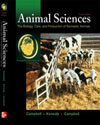
Ethology and Animal Behavior |  |
Chapter Summary| Behavior may be defined as the way an animal reacts to a certain stimulus with activity or inactivity. Ethology—the scientific study of animal behavior—is a complex subject. Many behavioral patterns in animals can be traced to their ancestors' abilities to survive in the wild. An understanding of the basic principles of animal behavior is necessary for successful animal husbandry.
Behavioral responses in all animals are determined by heredity and learning. Hereditary responses are innate and can be illustrated by an animal behaving in a certain way without a need to learn the behavior. This is sometimes called instinct. Certain types of behavior, however, must be learned through experience. Animals tend to act and respond in accordance with past experiences. The rapidity with which an individual learns is determined by its intelligence. Animals communicate with one another by sight, sound, smell, and touch. Communication plays an important role in animal behavior.
Typical categories of behavior include ingestive, eliminative, shelter-seeking, agonistic, sexual, mother–young, investigative, and gregarious. The importance of social dominance order in domestic animals and the relation of population density to social tension and hence to productive performance need further study if we are to better understand animal behavior and its role in the production of foods and services useful to humanity.
|
|
|